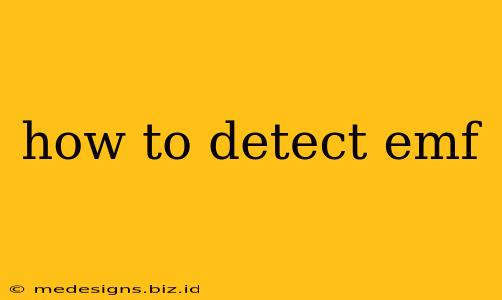Electromagnetic fields (EMF) are invisible forces surrounding electrical devices and power lines. While some levels of EMF exposure are considered safe, concerns about potential health effects have led many to want to detect EMF levels in their homes and environments. This guide will explore different methods for EMF detection, helping you understand what tools are available and how to interpret the results.
Understanding EMF and its Sources
Before diving into detection methods, it's crucial to understand what EMF is and where it comes from. EMF is a combination of electric and magnetic fields. Common sources include:
- Power lines: High-voltage transmission lines emit significant EMF.
- Electrical appliances: Household appliances like microwaves, refrigerators, and hair dryers generate EMF.
- Wi-Fi routers and cell phones: These devices emit radiofrequency (RF) EMF, a type of non-ionizing radiation.
- Smart meters: These digital electricity meters can also emit EMF.
- Electrical wiring in walls: The wiring in your home's walls creates electric fields.
Understanding these sources helps you focus your EMF detection efforts on areas of potential higher exposure.
Methods for Detecting EMF
Several methods exist for detecting EMF, ranging from simple to sophisticated.
1. Using a EMF Meter
The most reliable way to detect EMF is using a dedicated EMF meter or EMF detector. These devices measure the strength of both electric and magnetic fields, usually displaying readings in milligauss (mG) for magnetic fields and volts per meter (V/m) for electric fields. Different meters offer varying levels of sensitivity and features.
- Basic EMF meters: These are affordable and suitable for general EMF detection around the home. They typically measure both electric and magnetic fields.
- Advanced EMF meters: These meters offer greater accuracy, more detailed readings, and may include features like frequency analysis. These are useful for more detailed investigations.
- RF EMF detectors: Specific detectors are designed to measure radiofrequency EMF from devices like Wi-Fi routers and cell phones.
Choosing the right meter: Consider your needs and budget when selecting a meter. For home use, a basic meter is often sufficient. For more in-depth measurements, an advanced meter might be necessary.
2. Using Smartphone Apps
Several smartphone apps claim to detect EMF. However, the accuracy of these apps can vary significantly. While they might provide a general indication of EMF presence, they shouldn't be relied upon for precise measurements. Treat app readings as a preliminary assessment rather than definitive results.
3. Observing Your Surroundings
While not a precise measurement, being aware of your surroundings can offer clues to potential EMF sources. Living near high-voltage power lines or having many electrical appliances in close proximity could indicate higher EMF exposure.
Interpreting EMF Readings
Once you've taken EMF measurements, interpreting the results is crucial. There are no universally agreed-upon "safe" levels of EMF, and health effects from EMF exposure are still a subject of ongoing research. However, consistently high readings, especially above certain thresholds recommended by various organizations (though these vary considerably), may warrant further investigation.
Mitigating EMF Exposure
If you find high EMF readings in your home, several steps can help mitigate exposure:
- Distance: Increase the distance between yourself and EMF sources.
- Shielding: Use EMF shielding materials, such as specialized fabrics or paints, although their effectiveness varies significantly depending on the type and frequency of EMF.
- Timing: Limit your time spent near high-EMF sources.
Disclaimer: This article provides information for educational purposes only and does not constitute medical or professional advice. If you have concerns about EMF exposure and its potential health effects, consult with a qualified healthcare professional. Remember, the research on long-term health effects of low-level EMF exposure is ongoing and not fully conclusive.
